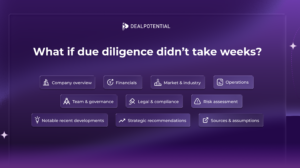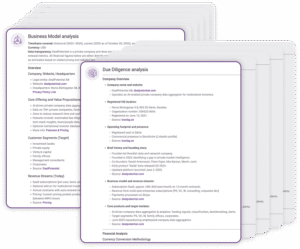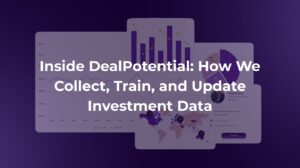
What if due diligence didn’t take weeks?
A leading US investment bank, focused on early- and growth-stage transactions, finally found a single tool to unify its fragmented deal intelligence.

The private investment world entered 2025 with high hopes. Many industry leaders had anticipated a rebound in deal activity following the turbulent macro environment of the previous two years. But just a few months into the year, one thing is clear: uncertainty still looms large, and investor behavior remains cautious. So what’s behind the slowdown—and why are some experts still placing their bets on a September shift?
At DealPotential
We’re tracking these deal flow trends closely. With renewed clarity on monetary policy and a backlog of dry powder waiting to be deployed, our view is a cautious-but-optimistic one: the investment outlook for September 2025 looks brighter than earlier quarters.
In this post we unpack the reasons for the slowdown, highlight emerging recovery signals, and explain why Q3 2025, especially September, may be the inflection point for private-market dealmaking.
🟣 Investor caution and fund-raising drag. Limited partners remain selective, favoring only top-tier firms with strong track records. Bain reports that after feeding deal-making in 2021, LPs sharply cut back on new allocations as exit proceeds slowed bain.com.
Buyout fund-raising fell sharply: Bain finds buyout funds raised 23% less capital in 2024 than in 2023 bain.com (North America was down 34%). GPs face mounting pressure to show distributions, over half of GPs say they feel high pressure from investors on exits
reuters.com.
In short, 2024 was characterized by risk aversion and locked-in positions. Rising rates and fading liquidity led many managers into a holding pattern. Deal-making volume in early 2025 still lagged historical norms. But even amid the gloom, signs of a turnaround have begun to emerge.
Why focus on September 2025 and Q3? A few data-informed reasons stand out:
Even though 2025 started off slow, there are now clear signs that the private market might be turning a corner.
According to Bain & Company, global private equity investments and exits bounced back in 2024 after two tough years. And in Q1 2025, EY reports that buyout deal activity picked up strongly – the number of deals rose by 45% compared to the same period last year, and total deal value more than doubled, helped by a few big-ticket transactions.
What does this mean? Simply put, firms are ready to invest again.
Even though many GPs still worry about trade tensions and tariffs, EY found that nearly 75% of them are willing to take more risk right now. EY survey in fact, market uncertainty is making some investors more opportunistic, they’re actively looking for undervalued assets and plan to move quickly when the timing is right. EY analysis
That’s a big shift, and it’s helping unlock deals that have been stuck in pipelines.
There’s also a massive amount of undeployed capital – often called “dry powder” – sitting on the sidelines. Bain estimates that PE firms held around $1.2 trillion in 2024, and 24% of that has been untouched for four years or more.
As soon as the market feels more stable, that money is likely to flood in — driving up M&A activity fast.
On top of that, analysts at Baird expect interest rate cuts through 2025. That means lower borrowing costs, better deal structures, and historically, it has triggered waves of leveraged buyouts (LBOs).
Momentum is also picking up among the investors themselves. In a recent McKinsey survey, 30% of limited partners (LPs) said they plan to increase their private equity allocations in the next 12 months – a big confidence boost for the market.
Meanwhile, many private equity firms have spent the past year strengthening their portfolios, improving operations, and cleaning up their balance sheets. EY
Once the macro environment improves, these better-prepared companies will be in a prime position for sale or further growth, and investors will be ready to act.
Bottom line? The pieces are starting to fall into place. Capital is ready. Sentiment is warming. And the private market could be heading for a real rebound, possibly as early as September.
Want to stay ahead of the curve? Explore our company database, track sector-specific deal trends on our market insights, or see how we help investors make smart investment decisions.
Book a free demo with DealPotential and get real-time insights on the next billion-dollar opportunities.
SHARE:

A leading US investment bank, focused on early- and growth-stage transactions, finally found a single tool to unify its fragmented deal intelligence.

Smarter valuations, sharper filters, and deeper insights, all live now.

Investment data intelligence drives smarter deal sourcing. Discover how DealPotential collects and trains private-market data.
We use cookies to improve your experience, analyze web traffic, deliver customized content, and support marketing efforts.
DealPotential Investment Intelligence Platform Proposal Agreement
WHEREAS, the Seller agrees to provide access to the DealPotential Investment Intelligence Platform,
WHEREAS, the Client agrees to purchase the DealPotential Investment Intelligence Platform according to the terms and conditions laid out in this contract.
THEREFORE, in consideration of the mutual agreement made by the parties hereto, the Seller and the Purchaser (individually, each a “Party” and collectively, the “Parties”) agree to the following:
2. Subscription: By subscribing to the Platform, you agree to pay the monthly or yearly subscription fee, as specified in your subscription plan.
3. Payment: Payment is due monthly in advance and processed via Stripe. The subscription renews automatically until cancelled.
4. Cancellation: You may cancel your subscription at any time, and it will take effect at the end of the current billing cycle. No refunds will be provided for partial months.
5. Data Privacy: We are committed to safeguarding your data. Please refer to our Privacy Policy for details on data handling and protection.
6. Intellectual Property: All content, data, and reports provided by the Platform are protected by intellectual property laws and are for your internal use only.
7. Termination: We reserve the right to terminate your access to the Platform for any violation of these terms or for any reason at our discretion.
8. Governing Law: These terms are governed by the laws of Sweden, and any disputes shall be subject to the exclusive jurisdiction of the courts in Sweden.
10. Disclaimer: We disclaim all responsibility for any decisions made by users based on the data provided in our platform. All investment decisions are solely the responsibility of the user. We are not involved in any user decisions and only provide data and assessments for informational purposes.